
Thebes, known to the ancient Egyptians as Waset, was an ancient Egyptian city located along the Nile about 800 kilometers (500 mi) south of the Mediterranean. Its ruins lie within the modern Egyptian city of Luxor. Thebes was the main city of the fourth Upper Egyptian nome and was the capital of Egypt for long periods during the Middle Kingdom and New Kingdom eras. It was close to Nubia and the Eastern Desert, with its valuable mineral resources and trade routes. It was a cult center and the most venerated city during many periods of ancient Egyptian history. The site of Thebes includes areas on both the eastern bank of the Nile, where the temples of Karnak and Luxor stand and where the city was situated; and the western bank, where a necropolis of large private and royal cemeteries and funerary complexes can be found. In 1979, the ruins of ancient Thebes were classified by UNESCO as a World Heritage Site.

Memphis or Men-nefer was the ancient capital of Inebu-hedj, the first nome of Lower Egypt that was known as mḥw ("north"). Its ruins are located near the modern town of Mit Rahina, 20 km (12 mi) south of Giza in Greater Cairo, Egypt.

The Karnak Temple Complex, commonly known as Karnak, comprises a vast mix of decayed temples, pylons, chapels, and other buildings near Luxor, Egypt. Construction at the complex began during the reign of Senusret I in the Middle Kingdom and continued into the Ptolemaic Kingdom, although most of the extant buildings date from the New Kingdom. The area around Karnak was the ancient Egyptian Ipet-isut and the main place of worship of the 18th Dynastic Theban Triad, with the god Amun as its head. It is part of the monumental city of Thebes, and in 1979 it was inscribed on the UNESCO World Heritage List along with the rest of the city. The Karnak complex gives its name to the nearby, and partly surrounded, modern village of El-Karnak, 2.5 kilometres north of Luxor.

Luxor is a modern city in Upper (southern) Egypt which includes the site of the Ancient Egyptian city of Thebes.

Amenhotep III, also known as Amenhotep the Magnificent or Amenhotep the Great, was the ninth pharaoh of the Eighteenth Dynasty. According to different authors, he ruled Egypt from June 1386 to 1349 BC, or from June 1388 BC to December 1351 BC/1350 BC, after his father Thutmose IV died. Amenhotep was Thutmose's son by a minor wife, Mutemwiya.

Senenmut was an 18th Dynasty ancient Egyptian architect and government official. His name translates literally as "mother's brother."

The Luxor Temple is a large Ancient Egyptian temple complex located on the east bank of the Nile River in the city today known as Luxor and was constructed approximately 1400 BCE. In the Egyptian language it was known as ipet resyt, "the southern sanctuary". It was one of the two primary temples on the east bank, the other being Karnak. Unlike the other temples in Thebes, Luxor temple is not dedicated to a cult god or a deified version of the pharaoh in death. Instead, Luxor temple is dedicated to the rejuvenation of kingship; it may have been where many of the pharaohs of Egypt were crowned in reality or conceptually.

Luxor Museum is an archaeological museum in Luxor, Egypt. It stands on the corniche, overlooking the east bank of the River Nile.
The Temple of Amenhotep IV was an ancient monument at Karnak in Luxor, Egypt. The structures were used during the New Kingdom, in the first four years of the 18th Dynasty reign of the Egyptian Pharaoh Akhenaten, when he still used the name Amenhotep IV. The edifices may have been constructed at the end of the reign of his father, Amenhotep III, and completed by Akhenaten.
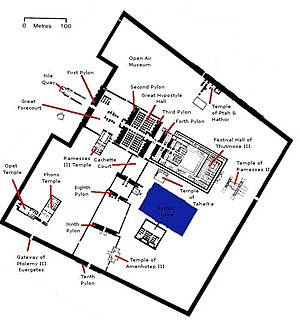
The Precinct of Amun-Re, located near Luxor, Egypt, is one of the four main temple enclosures that make up the immense Karnak Temple Complex. The precinct is by far the largest of these and the only one that is open to the general public. The temple complex is dedicated to the principal god of the Theban Triad, Amun, in the form of Amun-Re.

The Precinct of Mut is an Ancient Egyptian temple compound located in the present city of Luxor, on the east bank of the Nile in South Karnak. The compound is one of the four key ancient temples that creates the Karnak Temple Complex. It is approximately 325 meters south of the precinct of the god Amun. The precinct itself encompasses approximately 90,000 square meters of the entire area. The Mut Precinct contains at least six temples: the Mut Temple, the Contra Temple, and Temples A, B, C, and D. Surrounding the Mut Temple proper, on three sides, is a sacred lake called the Isheru. To the south of the sacred lake is a vast amount of land currently being excavated by Dr. Betsy Bryan and her team from the Johns Hopkins University in Baltimore, Maryland.

The Red Chapel of Hatshepsut or the Chapelle rouge was a religious shrine in Ancient Egypt.

Spanning over two thousand years, ancient Egypt was not one stable civilization but in constant change and upheaval, commonly split into periods by historians. Likewise, ancient Egyptian architecture is not one style, but a set of styles differing over time but with some commonalities.

The Opet Festival was an annual Ancient Egyptian Festival celebrated in Thebes (Luxor), especially in the New Kingdom and later periods, during the second month of the season of Akhet, the flooding of the Nile. The festival was celebrated to promote the Fertility of Amun-Re and the Pharaoh, who was also believed to be the spiritual offspring of Amun-Re; the Son/Daughter of Amun-Re. John Darnell argues that “Opet began on II Akhet 15 under Thutmose III and lasted 11 days ; by the beginning of the reign of Ramesses III, the festival stretched over 24 days.” The Festival included a ritual procession of the Barque of the cult statue of “Amun-Re, supreme god, his wife, Mut, and his son, Khons.” This procession carried the statue for 2 km from Karnak Temple to “Luxor Temple, destination of the Opet Feast.” Once at the Luxor Temple, a ritual marriage ceremony between the Pharaoh and Amun-Re took place in the Birth room, spiritually linking them to ensure the Pharaoh’s fertility and reinstate the Pharaoh as the intermediary between the gods and Egypt. During the marriage ceremony, the Pharaoh was ceremoniously reborn through a re-crowning ceremony, emphasising the fertile nature of the Pharaoh and legitimising his divine right to rule. The ancient festival has been survived by the present-day feast of Sheikh Yūsuf al-Haggāg, an Islamic holy man whose boat is carried around Luxor in celebration of his life.
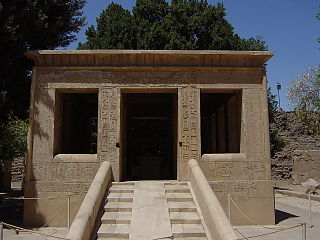
The White Chapel of pharaoh Senusret I, also referred to as the Jubilee Chapel of Senusret I, was built during the Middle Kingdom of Egypt. During the New Kingdom it was demolished and used as filler for the Third Pylon of the temple of Karnak, Precinct of Amun-Re.

Amenhotep, son of Hapu was an ancient Egyptian architect, a priest, a scribe, and a public official, who held a number of offices under Amenhotep III of the 18th Dynasty.

The history of the Karnak Temple complex is largely the history of Thebes. The city does not appear to have been of any significance before the Eleventh Dynasty, and any temple building here would have been relatively small and unimportant, with any shrines being dedicated to the early god of Thebes, Montu. The earliest artifact found in the area of the temple is a small, eight-sided column from the Eleventh Dynasty, which mentions Amun-Re. The tomb of Intef II mentions a 'house of Amun', which implies some structure, whether a shrine or a small temple is unknown. The ancient name for Karnak, Ipet-Isut only really refers to the central core structures of the Precinct of Amun-Re, and was in use as early as the 11th Dynasty, again implying the presence of some form of temple before the Middle Kingdom expansion.
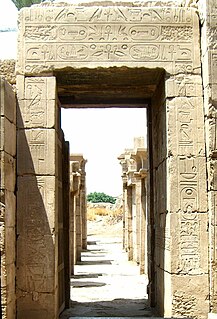
The Temple of Ptah is a shrine located within the large Precinct of Amun-Re at Karnak, in Luxor, Egypt. It lies to the north of the main Amun temple, just within the boundary wall. The building was erected by the Pharaoh Thutmose III on the site of an earlier Middle Kingdom temple. The edifice was later enlarged by the Ptolemaic Kingdom.
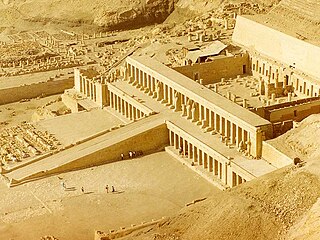
The Temple of Hatshepsut is a mortuary temple built during the reign of Pharaoh Hatshepsut of the Eighteenth Dynasty of Egypt. Located opposite the city of Luxor, it is considered to be a masterpiece of ancient architecture. Its three massive terraces rise above the desert floor and into the cliffs of Deir el-Bahari. Her tomb, KV20, lies inside the same massif capped by El Qurn, a pyramid for her mortuary complex. At the edge of the desert, 1 km (0.62 mi) east, connected to the complex by a causeway lies the accompanying valley temple. Across the river Nile, the whole structure points towards the monumental Eighth Pylon, Hatshepsut's most recognizable addition to the Temple of Karnak and the site from which the procession of the Beautiful Festival of the Valley departed. The temple's twin functions are identified by its axes: its main east-west axis served to receive the barque of Amun-Re at the climax of the festival, while its north-south axis represented the life cycle of the pharaoh from coronation to rebirth.
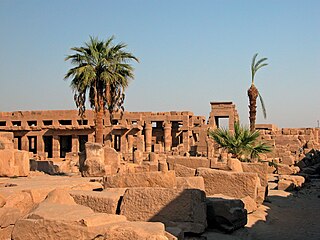
The Festival Hall of Thutmose III (Akh-menu) is an ancient shrine in Luxor (Thebes), Egypt. It is located at the heart of the Precinct of Amun-Re, in the Karnak Temple Complex. The edifice is normally translated as "the most glorious of monuments", but "monument to living spirit" is an alternative translation since akh can mean either glory or blessed/living spirit.





















